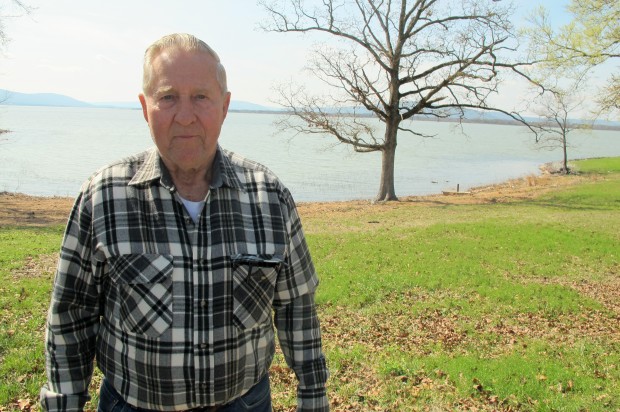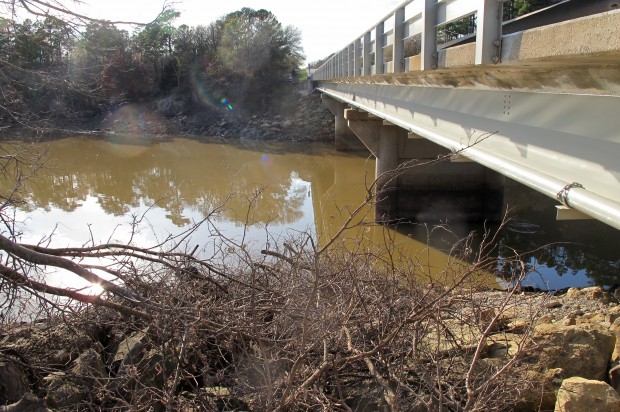The View From Sardis Lake: Why Moving Water to Where It’s Needed is So Hard
-
Logan Layden

Logan Layden / StateImpact Oklahoma
A sign along Oklahoma Highway 43 near Sardis Lake.
Moving water from where it’s plentiful to where it’s needed seems like a logical way to meet all Oklahomans’ future water needs. But water transfers are complicated, and not just because they’re expensive — but because communities with lots of water want to keep it. Nothing illustrates this tension/challenge/whatever better than Sardis Lake.
A bill passed by the state Senate — SB760 — would, among other things, study whether moving water from basin to basin is a viable way of mitigating drought, and started with the idea of moving water from the eastern part of the state to the west. But it’s not the first time people in southeast Oklahoma have faced the prospect of losing the water in their area.
Before the Lake
Byron Bohanon reminisces as he stands in what used to be his front yard.
“Grandpa Mahoney had 510 acres and this is what’s not under water,” he says. “My mother was born in 1914 and my dad was born in 1915, and they courted right here.”
That was before Sardis dam was built and the lake covered his old stomping grounds among the potato hills southeast of McAlester. Now, there’s a pavilion where his house was, just feet from a boat ramp and a beach. Jim Koopman also had his land condemned to build the lake in the 1970s.
“They sent a U.S. Marshall out to me and said to get my cattle off of their land,” Koopman says.
They remember the tiny — now submerged — town of Sardis.
“First barber shop I ever went to was there,” Bohanon says. “But it didn’t have electricity.”
Bohanon and Koopman say they and others like them gave up their land for the greater good of the area. Flooding was huge problem before the dam. And tourism promised to bring some kind of economic life to a downtrodden area. Fishing, boating, hiking, wildlife: The place is an outdoorsman’s dream.

Logan Layden / StateImpact Oklahoma
Jim Koopman had land condemned by the federal government to make way for Sardis Lake's construction.
Try, try, and try again
But almost as soon as Sardis filled with water, the rush was on to deal the rights to the water out of state. Andrew Husky with Oklahomans for Responsible Water Policy:
“And after they took the land from the people, built the lake, then real quickly they came and said, ‘Mr. Koopman, Mr. Bohannan, community, we’ve decided to transfer 93 percent to North Texas Municipal Water District,” Husky tells StateImpact.
Husky resigned his position with the Oklahoma Water Resources Board over that attempt to move the water to North Texas in the early 1990s. There was a heated public meeting one day. Then, at the state capitol the next day…
“They passed legislation to tell the OWRB to stop, do not go down there and sign that contract. This who thing is on hold,” Husky says. “If it wasn’t for about 300 people around here, North Texas Municipal Water District would have this lake.”
So, transfer attempt number one: failed.
Sardis is one of the few lakes built by the U.S. Army Corps of Engineers the state actually had to pay for. Often the state didn’t make those payments and has always been looking for someone else to take the responsibility, and the water.
The state tried again to transfer Sardis water to a different north Texas water district a decade later, a move that would prompt the state legislature to enact a seven-year moratorium on out of state water sales.
Transfer attempt number two: failed.
Then Oklahoma City gets into the act. Have a date on this? Oklahoma City currently pipes water from nearby Atoka Lake, but it’s not enough, and the plan is to transfer water from Sardis to Atoka, then to OKC along a new Atoka Pipeline.
“Right now they have water use permits, at the OWRB, for 90 percent of the lake,” Husky says.
The OWRB hasn’t been able to approve those permits because the Choctaw and Chickasaw Nations sued over the issue, claiming they hold the rights to Sardis Lake and all of the water in southeast Oklahoma. The parties in the case have been negotiating a settlement for four years with no end in sight.
Transfer attempt number three: on hold.

Logan Layden / StateImpact Oklahoma
Atoka Lake, currently a water source for Oklahoma City, near where Oklahoma Highway 43 meets U.S. Highway 69.
Why they fight
It’s easy to see why the people here don’t want to share. They don’t have to look any further than Oklahoma City’s Atoka Lake, just down the road.
“You cross the end of Atoka Lake, and as far as you can see back down through there there’s nothing but stumps and rotted trees and mud flats for, I mean, acres and acres of nothing but mud,” Jim Koopman says.
And he worries a draw-down like the one Oklahoma City did at Canton Lake in 2013 would devastate the thriving tourism industry towns like Clayton and Talihina rely on.
“It’s the life of Clayton,” Koopman says.
Even with the state legislature considering a bill to study the feasibility of moving water to drought-plagued southwest Oklahoma, Husky thinks the people around Sardis will ultimately get to keep what they see as their water.
“I think we’ll be having a celebration, maybe right here. We’ll have a party and celebrate preserving a natural asset like this for the community,” Husky says.
